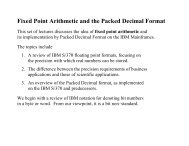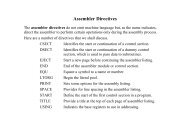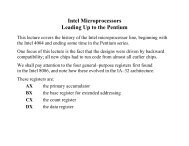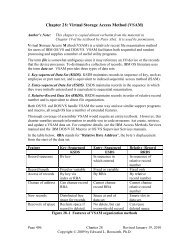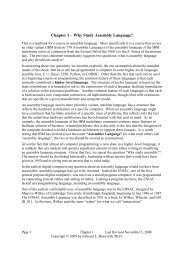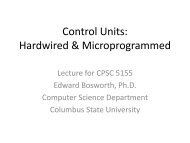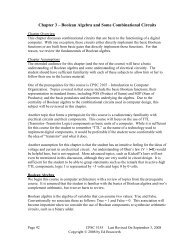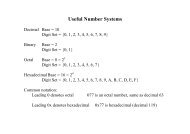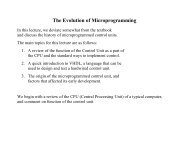Adobe PDF - Edwardbosworth.com
Adobe PDF - Edwardbosworth.com
Adobe PDF - Edwardbosworth.com
Create successful ePaper yourself
Turn your PDF publications into a flip-book with our unique Google optimized e-Paper software.
Chapter 15 Boz–7 Implementation of the CPU<br />
This leads to a simple statement defining this sequencing signal.<br />
S1 = 0 if and only if the assembly language opcode = 0x0F and branch = 0,<br />
where branch = 1 if and only if the branch condition is met.<br />
The sequencing signal S2 is used to control the entering of the defer code for those<br />
instructions that can use indirect addressing. Recall that the assignment of opcodes to the<br />
assembly language instructions has been structured so that only instructions beginning with<br />
“011” can enter the defer phase. Even these enter the defer phase only when IR 26 = 1.<br />
Thus, we have the following definition of this signal.<br />
S2 = 1 if and only if (IR 31 = 0, IR 30 = 1, IR 29 = 1, and IR 26 = 1)<br />
In a way, this is exactly the definition of the sequencing control signal S 2 as used in the<br />
hardwired control unit. The only difference is that in this design the signal S2 must be used<br />
independently of the signal S1, so we must use the full definition. The figure below<br />
illustrates the circuitry to generate the two sequencing signals S1 and S2.<br />
Given these circuits, we have the final form and labeling of the micro–words in the micro–<br />
memory. Note that there are no “micro–data” words, only microinstructions.<br />
Micro–Op B1 B2 B3 ALU M1 M2 S2 = 0 S2 = 1<br />
4 bit 4 bit 4 bit 4 bit 4 bit 4 bit 4 bit 8 bit 8 bit<br />
The form of the type 1 instruction is <strong>com</strong>pletely defined and can be given as follows.<br />
Micro–Op B1 B2 B3 ALU M1 M2 D = 0 D = 1<br />
0001 0x0 0x0 0x0 0x0 0x0 0x0 0x20 0x20<br />
But what exactly does this dispatch instruction do? The question be<strong>com</strong>es one of defining<br />
the dispatch table, which is used to determine the address of the microcode that is invoked<br />
explicitly by this dispatch. We now address that issue.<br />
Page 544 CPSC 5155 Last Revised July 9, 2011<br />
Copyright © 2011 by Edward L. Bosworth, Ph.D. All rights reserved.



